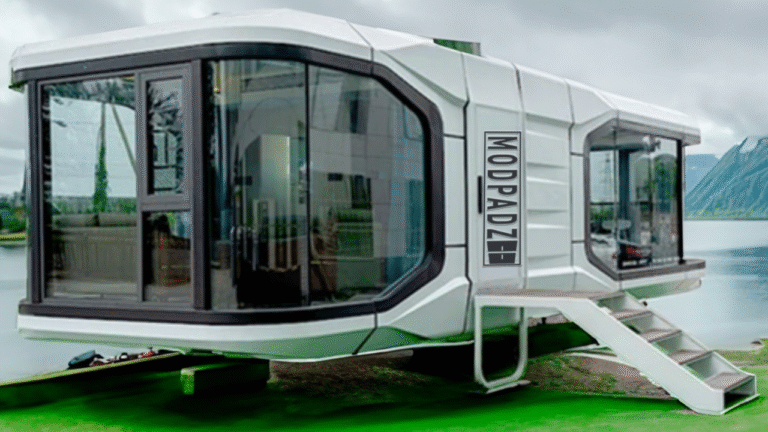Ever felt like your stuff is taking over your space—and your sanity? Well, welcome to the world of capsule house, where less really is more, and every square inch packs a punch. These pint-sized powerhouses of design are redefining modern living in a big way… by going small.
What Is a Capsule House?
Origins of Capsule Living
Capsule house didn’t just pop up overnight. The idea actually dates back to the 1970s in Japan, with architect Kisho Kurokawa’s Nakagin Capsule Tower. His vision? A modular, compact future where people could live efficiently in bustling cities. Fast forward to today, and capsule homes have evolved from futuristic fantasy to real-world solution.
Defining Features of a Capsule House
So, what makes a house a “capsule”? Think micro-living with a high-function twist:
-
Compact floor plan (100–300 sq. ft)
-
Modular or prefabricated design
-
Multi-functional furniture (think fold-out beds, hidden tables)
-
Smart use of vertical space
-
Minimalist aesthetic
Why Capsule Houses Are Gaining Popularity
The Appeal of Minimalism
In a world obsessed with more, capsule houses are a refreshing whisper of “less is better.” Stripping down to essentials forces people to declutter not just their homes but also their minds. It’s like Marie Kondo meets architecture.
Urban Space-Saving Solutions
Big cities are running out of room—and fast. capsule house let urban dwellers live affordably without giving up location. It’s like getting front-row seats to city life without paying the penthouse price.
Sustainability and Eco-Friendliness
Less space = less energy used. These homes often use recycled materials, solar panels, and water-saving features. It’s like giving Mother Nature a well-deserved high-five.
Inside a Capsule House: What to Expect
Interior Layout and Design
While compact, capsule houses aren’t coffin-like (we promise). With smart design, they feel surprisingly open.
Smart Storage Hacks
You’ll find drawers under the stairs, cabinets behind mirrors, and beds that slide into walls. Every nook is optimized to the max.
Multi-Functional Furniture
A sofa becomes a bed. A dining table folds into the wall. A staircase hides a closet. Magic? Nope—just clever design.
Types of Capsule Houses
Prefabricated Capsule Homes
These are built in a factory and delivered to your site ready to go. No mess, no fuss, and perfect for quick builds.
Capsule Apartments in Big Cities
Popular in Tokyo and Seoul, these stacked micro-units offer cheap, efficient housing in premium locations—perfect for students and young workers.
Off-Grid Capsule Cabins
Want to unplug? Off-grid capsule houses use solar power, composting toilets, and rainwater collection—ideal for nature lovers and digital detoxers.
Pros and Cons of Capsule Houses
Advantages You’ll Love
-
Lower utility bills
-
Affordable to build or rent
-
Minimal maintenance
-
Encourages a simpler lifestyle
-
Eco-friendly living
Possible Downsides to Consider
-
Limited space (duh)
-
Less privacy if shared
-
Might feel cramped for families
-
Zoning laws can be tricky in some areas
Who Should Consider Living in a Capsule House?
Digital Nomads and Minimalists
Travel light, live lighter. Capsule homes are tailor-made for those who hate being tied down and love new adventures.
Students and Young Professionals
Can’t afford a full apartment? Capsule living offers an affordable, private space with everything you need and nothing you don’t.
Environmental Enthusiasts
Capsule living is often synonymous with sustainable living. It’s the perfect step toward reducing your carbon footprint.
Cost of Building or Renting a Capsule House
Buying vs. Renting
-
Buying a capsule home: Prices range from $15,000 to $50,000 depending on size, features, and location.
-
Renting: Monthly costs can be as low as $300–$800 in urban centers.
How Much Do They Cost?
Prefabricated capsule homes generally cost $200–$400 per square foot. The good news? You need way fewer feet!
Where Can You Find Capsule Houses?
Japan: The Birthplace of Capsule Culture
From capsule hotels to compact apartments, Japan has mastered the art of micro-living. It’s ground zero for this innovative housing trend.
Global Expansion and Trends
Countries like the U.S., China, Germany, and the Netherlands are jumping on the capsule bandwagon. In fact, tiny house villages and modular communities are popping up everywhere!
The Future of Capsule Living
Smart Tech Integration
Future capsule houses will integrate AI, IoT, and voice-controlled systems. Imagine your house adjusting the lighting and temperature before you even walk in. Sci-fi? Nope, just future-normal.
Potential in Crisis Housing
Capsule units are also being used in disaster zones and refugee camps. They can be assembled quickly, cheaply, and provide immediate shelter—proof that good design can save lives.
Conclusion
So, what’s the big deal with these tiny homes? capsule house are more than just a design trend—they’re a movement. One that prioritizes function over flash, mindfulness over materialism, and smart living over sprawling luxury.
Whether you’re a minimalist at heart, a budget-conscious student, or just someone looking to break free from the clutter—capsule living might just be the perfect fit. Small space, big possibilities.
FAQs
1. Are capsule houses legal in all countries?
Not always. Zoning laws vary, and some places have minimum size requirements for dwellings. Always check local regulations first.
2. Can a family live in a capsule house?
Technically yes, but it might be tight. Some capsule houses are designed for 2–3 people, but families may find it challenging long-term.
3. Are capsule homes safe during natural disasters?
Many prefab capsule homes are built with durability in mind, including weather-resistant materials. Always verify the safety specs.
4. Can I customize a capsule house?
Absolutely! From layout to finishes, many manufacturers offer customization options to match your style and needs.
5. How do capsule houses affect mental health?
It depends. Some find peace in minimalism, while others may feel claustrophobic. It’s crucial to design the space thoughtfully and test the lifestyle before going all in.

